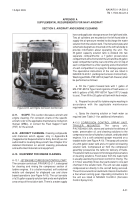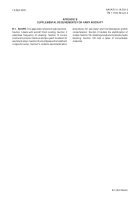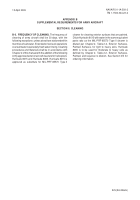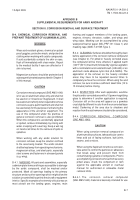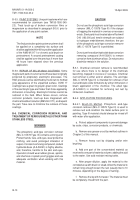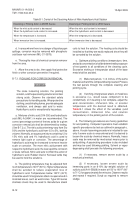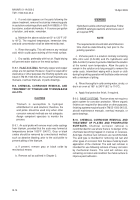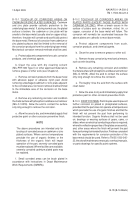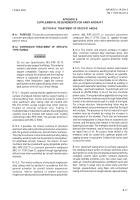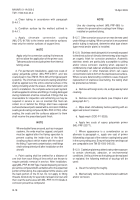TM-1-1500-344-23-2 - Page 211 of 240
B-9
NAVAIR 01-1A-509-2
TM 1-1500-344-23-2
15 April 2009
d. Thoroughly rinse the solution from the surface
with plenty of clean water.
e. Repeat the preceding sequence as necessary
until all corrosion products have been removed and the
metal has a bright appearance.
f. Apply the chemical pretreatment and final
protective finish recommended for the area.
B-5.4. PRE-TREATMENT PROCESSES (BRUSH
APPLICATION). Chemical pre-treatment, such as the
chromic acid brush- on solution, provides a passive
surface layer with an inhibitive characteristic that resists
corrosive attack and also provides a bond for subsequent
coatings. Properly applied magnesium pre-treatment
tend to neutralize corrosion media in contact with the
surface. Numerous type treatments are available;
however, for the purpose of this manual, the following
brush-on treatment corresponding to Type VI of
Specification AMS-M-3171 is given. The pre-treatment
shall be applied immediately after paint removal and
washing in order to prevent corrosion and surface
deterioration.
B-5.4.1. Chromic Acid Brush-On Pretreatment. The
chromic acid brush-on pretreatment may be applied to
all magnesium parts that require touchup. This treatment
is generally used in refinishing procedures or when
parts and assemblies are too large to be immersed. This
treatment is less critical to apply than the other brush-
on treatments, is relatively inexpensive, not as harmful
when trapped in faying surfaces and does not present
the toxicity hazards of the other brush-on treatments.
Ensure that all contaminants, grease, and oil are removed
prior to the treatment process.
B-5.4.1.1. Preparation.
WARNING
When preparing the chromic acid brush-on
pretreatment, add the chemicals to the water in
the order shown below, stirring the solution
vigorously, either mechanically or by agitation,
for at least 15 minutes. Avoid skin contact or
inhalation of acid fumes.
B-5.4.1.2. Add 1-1/3 ounces (37.8 grams) of technical
grade chromic acid (A-A-55827) and one ounce (28.3
grams) of calcium sulfate (CaSO
4
-2H
2
0) to enough
water to make one gallon in a container constructed
from stainless steel, aluminum, vinyl, polyethylene, or
rubber. The operating temperature range is 70
°
to 90
°
F
(21
°
to 32
°
C). After mixing, the pH of the solution should
be between 1.1 and 1.6. Adjust with acid if the pH is
greater than 1.6 and with water if the pH is less than 1.1.
B-5.4.1.3. Application Procedure.
a. Clean the surfaces to be treated (see B-4.2). A
water break test is recommended if the cleanliness of
the surface is in doubt.
b. Apply the coating solution by brush, swab, or a
low pressure, non-atomizing spray. Keep the receiving
surfaces wet throughout the treatment operation until
the required or specified coating film is produced. Under
optimum conditions (i.e., at temperatures of 70
°
F (21
°
C)
or above, and using fresh materials), the time required
is usually one to five minutes; up to one to two minutes
of treatment should produce a brassy film, and three to
five minutes should produce a dark brown coating.
Under adverse conditions, and if the desired or specified
finish color is not produced in the specified time, the
treatment may have to be prolonged (up to 20 to 30
minutes in some instances) until the proper finish is
obtained. For good paint adhesion, a dark brown color
free of powder is considered best. The color may vary
in using different manufacturers materials.
NOTE
Too long an exposure to the brush-on solution
produces coatings which will powder and impair
adhesion of applied paint finish and films.
c. The coating should be closely observed during
the treatment for color changes, rinsed with cold running
water when the desired condition or color is reached,
and air dried. The preparation and use of test panels,
made of the same material and under the same
conditions, prior to starting the actual treating operation
may be used as an aid in determining the application
time required to produce the necessary coating. A good
coating is uniform in color and density, adheres well,
and is free of loose powder.
d. Apply wash primer (MIL-C-8514) to the treated
surface as soon as practical after thorough drying.
e. Apply recommended final protective finish.
Back to Top

